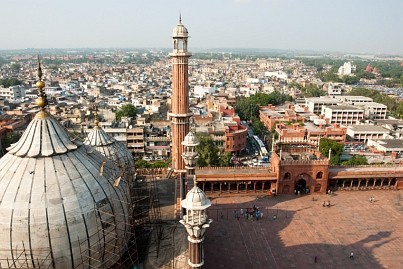
Thought to be more than 5,000 years old, India's capital is one of the world's oldest existing cities. Having been destroyed and rebuilt 11 times, Delhi has a colorful history which is represented by a collection of ancient monuments and buildings, including three UNESCO World Heritage sites.
The sprawling city is India's largest metropolis by area, and the world's eighth largest in terms of population. As the major cultural, commercial and political centre of India, Delhi is a cosmopolitan city.
Along with the plethora of ancient treasures, medieval monuments and archeological sites, the city also boasts a sophisticated, modern side. This delectable mix of old and new adds to the city's appeal as a tourist destination.
The crumbling Old Delhi quarters serve as capital of the country's Islamic community, while the expansive New Delhi houses the Parliament of India. Delhi is a multifaceted city; not only is the city divided into two worlds of old and new, it is home to a diverse range of cultures.
The heterogeneous blend of people residing in the city adds further flavor and flair to Delhi's culture. Visitors can sip from this bubbling melting pot of culture, cuisine and dialect as they explore the city.
This area of the city occupies the west bank of the River Yamuna and is steeped in a rich distillate of history and culture. Visitors can experience atmospheric bazaars, medieval monuments and interesting archeological discoveries. This area of the city is crowded and congested, but all expeditions are well rewarded. Many of the city's top attractions are situated in these ancient quarters, including the Red Fort, Jama Masjid and Khari Baoli (Asia's largest spice market).
Built south of the old city in the 1920s, New Delhi was announced capital of India when the country gained independence from Britain in 1947. This area houses federal buildings and important offices, as well as an array of modern architectural marvels. A string of upmarket cafés, bars and restaurants add to the city's modern façade, and provide a comfortable resting place where visitors can ponder the contrasting elements of this north Indian metropolis.
Delhi's most fashionable district offers tourists a complete range of facilities. The city's top hotels, markets, monuments and entertainment are located in this area. It is also home to the city's largest green space, which is a welcome oasis in this urban jungle. There is also a pleasing mix of old and new buildings in this area, with ancient historic ruins such as Hauz Khas intermingled with modern developments including the Lotus Temple.
The west of the city is dominated by large residential blocks such as Patel Nagar, Punjabi Bagh and Tilak Nagar. The city has experienced rapid development over the last decade, and it is very evident from the amount of building in this area.
Districts in the east of the city include the dense residential areas of Preet Vihar, Gandhi Nagar and Shahadara. There is little to interest tourists in this area; however, it's an indication of how much the city has grown horizontally.
This area of the city occupies the west bank of the River Yamuna and is steeped in a rich distillate of history and culture. Visitors can experience atmospheric bazaars, medieval monuments and interesting archeological discoveries. This area of the city is crowded and congested, but all expeditions are well rewarded. Many of the city's top attractions are situated in these ancient quarters, including the Red Fort, Jama Masjid and Khari Baoli (Asia's largest spice market).
Built south of the old city in the 1920s, New Delhi was announced capital of India when the country gained independence from Britain in 1947. This area houses federal buildings and important offices, as well as an array of modern architectural marvels. A string of upmarket cafés, bars and restaurants add to the city's modern façade, and provide a comfortable resting place where visitors can ponder the contrasting elements of this north Indian metropolis.
Delhi's most fashionable district offers tourists a complete range of facilities. The city's top hotels, markets, monuments and entertainment are located in this area. It is also home to the city's largest green space, which is a welcome oasis in this urban jungle. There is also a pleasing mix of old and new buildings in this area, with ancient historic ruins such as Hauz Khas intermingled with modern developments including the Lotus Temple.
The west of the city is dominated by large residential blocks such as Patel Nagar, Punjabi Bagh and Tilak Nagar. The city has experienced rapid development over the last decade, and it is very evident from the amount of building in this area.
Districts in the east of the city include the dense residential areas of Preet Vihar, Gandhi Nagar and Shahadara. There is little to interest tourists in this area; however, it's an indication of how much the city has grown horizontally.